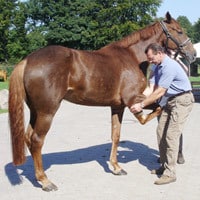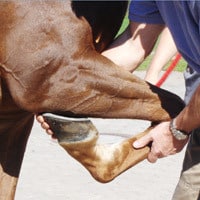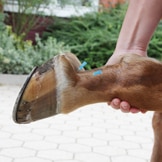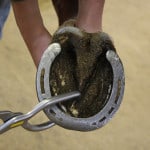The emphasis of our hospital lies in the orthopedics, including diagnostic and therapy of lameness, back or neck pain as well as limb deformities. Beside a thorough clinical investigation different modern imaging techniques are available – digital radiography, ultrasonography, nuclear scintigraphy and MRI.
We offer a wide range of modern approved therapies containing joint injections, ultrasonographically guided tendon and joint injections, shock wave therapy, cryotherapy and regenerative therapy forms (IRAP, PRP, ACP, bionic cell therapy, stem cell therapy).
Another main profession of our hospital is orthopedic surgery, including arthroscopy, fracture repair (osteosynthesis), surgical intervention of limb deformities and traumata.
Lameness examination
Lameness diagnosis is based on a thorough clinical investigation in the standing horse as well as in motion which includes examination on hard and/or soft ground. Flexion tests are helpful in diagnosing latent pain and accordingly in localizing the painful area. Evaluation of the lameness in soft ground at the longe or under the rider is also possible.
Diagnostic local anaesthesias are routinely used to localize exactly the painful area. Afterwards different imaging techniques like digital radiography and ultrasonography are necessary to get more information about pathological changes.
Radiography is the method of choice to visualize bony changes whereat ultrasonography is more helpful in soft tissue (tendons, muscles, ligaments and vessels) and bony surface pathologies. According to these techniques nuclear scintigraphy can be done in cases of mild intermittent or acute severe lameness.
In more complicated medical findings MRI or diagnostic arthroscopy can give more detailed information.
- lameness examination
- flexion test
- palpation
- nerve block
- hooftester
Back pain and misbehavior when being ridden
Most of the patients showing misbehavior when being ridden have occult neck or back problems. Investigation of these horses contains also a presentation under the daily rider and sometimes also under an unknown rider.
In most cases radiographs of the spine are the first diagnostic step. If there is no clear diagnosis possible with radiographs nuclear scintigraphy is the method of choice to visualize inflammatory foci or areas of high metabolism within the neck and/or back region. Afterwards we are able to administer a more focused treatment with injections or shock wave therapy.
Additionally chiropractic is used in our hospital to diagnose and treat spinal problems.
Beside our local treatment a special training program is essential for the outcome of the therapy. Our vets will help you to find the best way of training for you and your horse.
Limb deformities
Primary or acquired limb deformities (flexural and angular limb deformities) play a major role in orthopedic foal diseases. Especially in the young foal conservative treatment can achieve sustained success.
Radiographic views are obtained to assess and measure the degree of angulation, find the best treatment and control the progress. The first line of treatment is usually conservative management including glue-on-hoof-shoes, splinting and shock wave therapy to manipulate the growth plate. In severe cases surgery is essential. Depending on the kind of deformity we do periosteal transsections, temporary transphyseal bridging and sections of the check ligaments.









